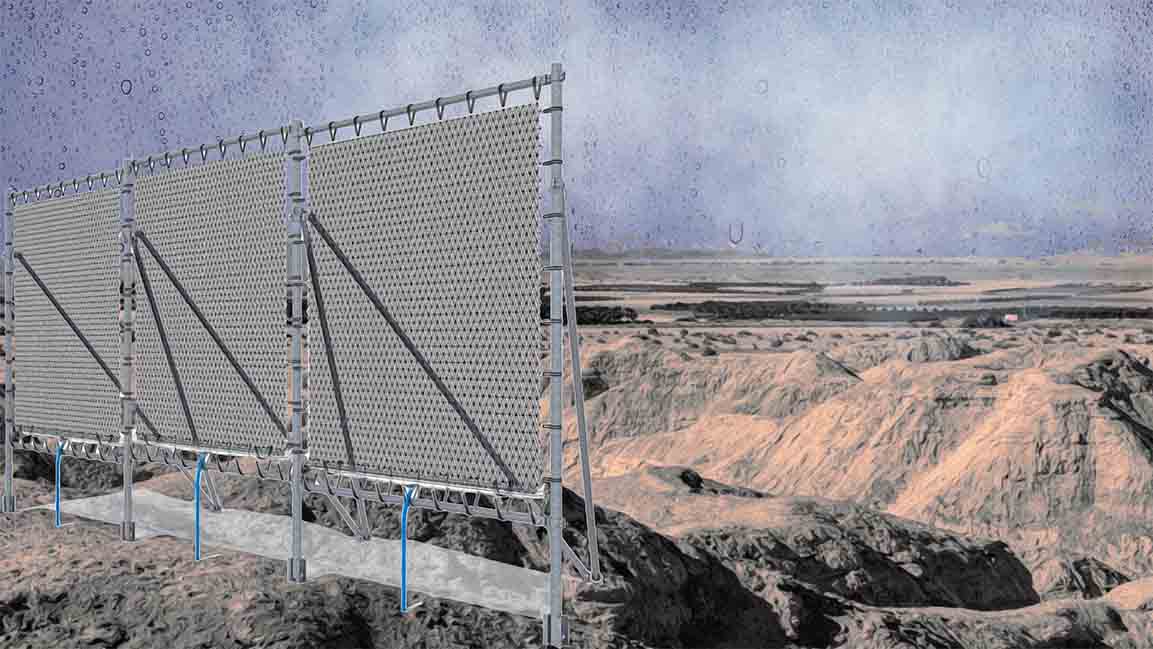- | 12:00 pm
Can harvesting fog solve the water crisis in the Middle East?
With the Middle East's water resources being stretched to their limits, can technological advancements provide a sustainable solution to this issue?

In Same’a, a district in Yemen, two teenage neighbors, Suhaim and Khalida, face a challenging situation as they live atop a mountain peak, where fetching water for their families is taxing. Every day, they have to walk for miles to reach the nearest water source, but even then, the water is frequently contaminated and unsuitable for consumption. The severity of this issue has reached a catastrophic level, mainly due to high population growth and the region’s vulnerability to climate change.
The Middle East and North Africa (MENA) are among the most vulnerable places in the world to climate change. The UN has highlighted the devastating toll that climate change will have on the region’s water supplies and food production systems.
In such a scenario, exploring alternative water-harvesting technologies offers a potential solution to the water scarcity crisis.
Researchers at the Smart Materials Lab (SML) and the Center for Smart Engineering Materials (CSEM) at NYU Abu Dhabi (NYUAD) have developed a new method of collecting water from fog and dew.
Research scientist Patrick Commins, post-doctoral associate Marieh B. Al-Handawi and director of the Center for Smart Engineering Materials Panče Naumov have observed water condensing from vapor to liquid form and moving across the surface of an organic crystal caused by changes in the width of small channels on the crystal’s surface – a fungicide was utilized to demonstrate the movement of small particles on the surface of the crystal. It’s a technology that could produce water for people residing in dry areas of the Middle East.
FRESHWATER SCARCITY AND ALTERNATIVE SOURCES
Due to climate change, population growth, and surface water basin depletion, the amount of available freshwater is decreasing. While 70% of the planet is water, only 2.5% is fresh and accessible, with much frozen or underground. Only a tiny fraction, 0.03%, is in the form of rivers and lakes, and some of these sources are contaminated.

Image: NYUAD
Al-Handawi says, “Fog and dew are abundant sources of non-conventional water, with up to 13 trillion m3 available through fog alone. As a result, we are developing alternative water-harvesting technology to meet the increasing demand for fresh water.”
Naumov mentioned that the material’s plastic behavior was initially interesting due to its ability to bend without breaking, which is often observed on the surface. However, researchers noticed dust particles moving on the crystal’s surface in Abu Dhabi’s sandy air during experiments. Microscopic techniques such as optical and atomic force microscopy were used to observe changes in surface topology under controlled humidity.
“The unexpected results could impact important technological processes such as humidity harvesting and nucleation processes in the pharmaceutical industry.”
Commins says, “With humidity, the changing surface topology allows condensed water to move across the surface. This corrugated topography plays a key role in the autonomous flow and particle transport observed in the study. We believe other materials with evolving surface morphology could also transport water and particles at the liquid-air interface.”
INDUSTRIAL IMPLICATIONS
This innovation has industrial implications, especially for the renewable energy sector. For example, it could be used for solar panels installed in deserts that need constant cleaning to remove sand and debris from the surface, as it significantly reduces their efficiency in collecting solar energy. Researchers say, instead, the surface could be made dynamic, allowing self-cleaning using condensed water overnight with no sunlight and low humidity.
“This is only one example of many other implications that this discovery could have for technologically and industrially relevant processes that occur at solid surfaces,” added Al-Handawi.
THE IMPACT
The goal is to address global challenges, particularly those of the Middle East, by studying fundamental phenomena.
Al-Handawi explained that this innovation has the potential to be applied in water-stressed countries, such as the UAE, Saudi Arabia, Bahrain, and Kuwait, which heavily rely on seawater desalination to provide fresh water to their population. Moreover, the UAE and Saudi Arabia have pledged to reduce energy consumption in their water desalination sectors by adopting innovative technologies.
The crystal’s ability to collect and transport water is autonomous, requiring zero added energy, making it highly sustainable. The phenomenon is driven by physical processes occurring naturally at surfaces in environments with high humidity and above temperatures where sublimation occurs, with no external input of energy required. The method extracts energy from the environment, promoting sustainability.
“The discovery is in its early stages, and while it has the potential for further development, it does broaden our understanding and presents a fundamentally novel approach to autonomous water transportation,” says Commins.
However, direct comparison with currently available technologies is not straightforward, given the proposed method presents a fundamentally different principle for water collection and transport at solid surfaces. Bringing this technology to practical use would require laboratory design, optimization, and testing in real-world conditions.






































